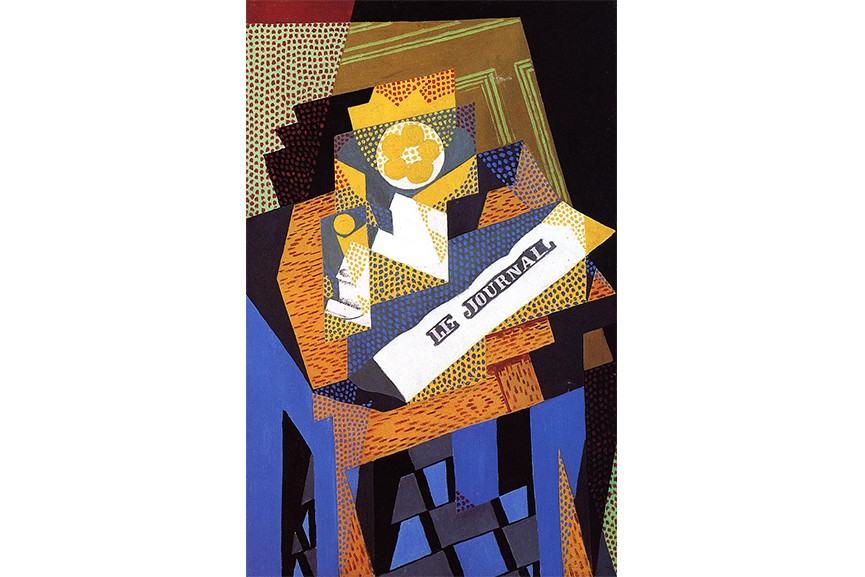
In order to fully grasp the ideas of Synthetic Cubism, one needs to understand its forerunner as well. Georges Braque - Fruit Dish and Glass, 1912 - Image via Characteristics of Synthetic Cubism Besides establishing an entirely new medium that will prove to be crucial to many movements of the 20th century, it should also be noted that Synthetic Cubism blurred the line between painting and sculpture as most of its pieces had relief-like characteristics within their compositions. Picasso's first collage piece titled Still Life with Chair Caning was created during the May of 1912, whilst Braque's first papier collé (translated as pasted paper) called Fruit Dish with Glass was created in September of the same year. This new art form integrated signs and fragments of real things and was integral to the development of the movement. Juan Gris - The Sunblind 1914 - Image via The Invention of CollageĪmong other things, the concept of collage as a medium is a direct result of Synthetic Cubism. By expanding the movement to its second and final act, the authors gave themselves the creative freedom to depict the world around them however they saw fit. Authentic pieces of paper replaced painted flat depictions of paper, real music notebooks replaced drawn musical notation, etc. It bridged the gap between reality and art by literally interpolating pieces of the real world onto the canvas. Analytic Cubism was concentrated on the act of taking apart or deconstructing an object, but Synthetic Cubism was all about its construction or synthesis. However, as the Synthetic Cubism started to establish its own set of rules, the art scene of Europe was taken by storm. The previous analytical approach was essentially based on breaking down an object into a fragmentary image, while the next phase developed interest in flattening the image and sweeping away all traces of allusion to a three-dimensional space.īy the time Analytic Cubism came to an end, it already broke the centuries-old rules of painting by providing an alternative to single point linear perspective. It introduced many new conceptual alternatives to the already established aesthetics of Cubism. Synthetic Cubism is generally considered to have occurred between the years of 19. Although the first phase was quite innovative in its own right, the latter was arguably the most imaginative period of early avant-garde art which took the movement to its extremes. Learn more about Cubism in History of Cubism, Analytic Cubism and Synthetic Cubism.In order to classify the revolutionary Cubist experiments made by Georges Braque, Picasso and Juan Gris, art historians tend to divide this movement into two main stages called Analytic and Synthetic Cubism. The inclusion of real objects directly in art is seen the start of one of the most important ideas in contemporary and modern art.

Whereas in Analytic Cubism the small facets of a dissected or “analyzed” object are reassembled to evoke that same object, Synthetic cubist works often include collaged real elements such as newspapers.

In this period, the favourite motifs of Cubists were still lifes with musical instruments, bottles, pitchers, glasses, newspapers and the human face and figure.
SYNTHETIC CUBISM SERIES
In the first phase Cubists reduced objects to just a series of overlapping planes and lines mostly in near-monochromatic browns, greys or blacks. Over the years, Cubism developed into two distinct phases: the initial and more austere Analytic Cubism, and later phase of the movement known as Synthetic Cubism. The name Cubism derived from a comment made by the French art critic Louis Vauxcelles who described some of Georges Braque’s paintings exhibited in Paris in 1908 and influenced by the late work of the Impressionist artist Paul Cézanne as reducing everything to ‘geometric outlines, to cubes’.Ĭubism is seen as a revolutionary movement that rejected to consider art as a pure imitation of nature and refused to adopt the traditional techniques of perspective, which had been used to depict space since the Renaissance. Cubist artists wanted instead to emphasize the two-dimensional flatness of the canvas. In their artworks objects are analysed, broken up into a multitude of small facets and then reassembled into geometric forms to evoke the same figures and to show the subjects from multiple views. By breaking objects and figures down into distinct areas or planes, the artists aimed to propose a revolutionary new approach to represent reality.

It was founded around 19 by Pablo Picasso and Georges Braque with the aim to reject the traditional techniques of perspective, modelling and chiaroscuro and refuting the idea of art as pure imitation of nature. Cubism was one of the most influential art movement of the 20 th century.


 0 kommentar(er)
0 kommentar(er)
